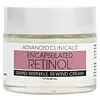What's inside
What's inside
 Key Ingredients
Key Ingredients

 Benefits
Benefits

 Concerns
Concerns

 Ingredients Side-by-side
Ingredients Side-by-side

Water
Skin ConditioningC12-15 Alkyl Benzoate
AntimicrobialBehenyl Behenate
EmollientGlycerin
HumectantSqualane
EmollientButylene Glycol
HumectantCetyl Palmitate
EmollientPolyhydroxystearic Acid
EmulsifyingPolyglyceryl-10 Stearate
Skin ConditioningPanthenol
Skin ConditioningDimethicone
EmollientPhenoxyethanol
PreservativeCarbomer
Emulsion StabilisingEuphorbia Cerifera Cera
AstringentSodium Stearoyl Lactylate
EmulsifyingTocopheryl Acetate
AntioxidantSodium Hydroxide
BufferingEthylhexylglycerin
Skin ConditioningPentylene Glycol
Skin ConditioningSerine
MaskingSodium Lactate
BufferingLactic Acid
BufferingUrea
BufferingFomes Officinalis Extract
Skin ProtectingSorbitol
HumectantPantolactone
HumectantPEG-40 Hydrogenated Castor Oil
EmulsifyingBisabolol
MaskingBorago Officinalis Seed Oil
EmollientSodium Chloride
MaskingPropylene Glycol
HumectantAllantoin
Skin ConditioningCamellia Sinensis Leaf Extract
AntimicrobialWater, C12-15 Alkyl Benzoate, Behenyl Behenate, Glycerin, Squalane, Butylene Glycol, Cetyl Palmitate, Polyhydroxystearic Acid, Polyglyceryl-10 Stearate, Panthenol, Dimethicone, Phenoxyethanol, Carbomer, Euphorbia Cerifera Cera, Sodium Stearoyl Lactylate, Tocopheryl Acetate, Sodium Hydroxide, Ethylhexylglycerin, Pentylene Glycol, Serine, Sodium Lactate, Lactic Acid, Urea, Fomes Officinalis Extract, Sorbitol, Pantolactone, PEG-40 Hydrogenated Castor Oil, Bisabolol, Borago Officinalis Seed Oil, Sodium Chloride, Propylene Glycol, Allantoin, Camellia Sinensis Leaf Extract
Water
Skin ConditioningCaprylic/Capric Triglyceride
MaskingDimethicone
EmollientGlyceryl Stearate
EmollientAmmonium Acryloyldimethyltaurate/Vp Copolymer
Cetearyl Phosphate
Skin ConditioningCetyl Alcohol
EmollientBehenyl Alcohol
EmollientGlycerin
HumectantRetinol
Skin ConditioningFerulic Acid
AntimicrobialPalmitoyl Tripeptide-37
Skin ConditioningPyrus Malus Fruit Extract
Skin ConditioningButyrospermum Parkii Butter
Skin ConditioningSclerocarya Birrea Seed Oil
HumectantRosa Canina Fruit Oil
EmollientOryza Sativa Bran Extract
Skin ConditioningRosmarinus Officinalis Leaf Extract
AntimicrobialHelianthus Annuus Extract
EmollientDimethicone Crosspolymer
Emulsion StabilisingCurcuma Longa Root Extract
MaskingCopernicia Cerifera Cera
EmollientPropanediol
SolventSodium Cocoamphoacetate
CleansingRosa Damascena Flower Water
MaskingPunica Granatum Fruit Extract
AntioxidantCamellia Sinensis Leaf Water
MaskingLavandula Angustifolia Oil
MaskingTocopheryl Acetate
AntioxidantSynthetic Beeswax
Emulsion StabilisingBHT
AntioxidantXanthan Gum
EmulsifyingBHA
AntioxidantSilica Dimethyl Silylate
EmollientPhenoxyethanol
PreservativeTocopherol
AntioxidantTetrasodium Glutamate Diacetate
Caprylyl Glycol
EmollientEthylhexylglycerin
Skin ConditioningHexylene Glycol
EmulsifyingSodium Hydroxide
BufferingLinalool
PerfumingWater, Caprylic/Capric Triglyceride, Dimethicone, Glyceryl Stearate, Ammonium Acryloyldimethyltaurate/Vp Copolymer, Cetearyl Phosphate, Cetyl Alcohol, Behenyl Alcohol, Glycerin, Retinol, Ferulic Acid, Palmitoyl Tripeptide-37, Pyrus Malus Fruit Extract, Butyrospermum Parkii Butter, Sclerocarya Birrea Seed Oil, Rosa Canina Fruit Oil, Oryza Sativa Bran Extract, Rosmarinus Officinalis Leaf Extract, Helianthus Annuus Extract, Dimethicone Crosspolymer, Curcuma Longa Root Extract, Copernicia Cerifera Cera, Propanediol, Sodium Cocoamphoacetate, Rosa Damascena Flower Water, Punica Granatum Fruit Extract, Camellia Sinensis Leaf Water, Lavandula Angustifolia Oil, Tocopheryl Acetate, Synthetic Beeswax, BHT, Xanthan Gum, BHA, Silica Dimethyl Silylate, Phenoxyethanol, Tocopherol, Tetrasodium Glutamate Diacetate, Caprylyl Glycol, Ethylhexylglycerin, Hexylene Glycol, Sodium Hydroxide, Linalool
 Reviews
Reviews

Ingredients Explained
These ingredients are found in both products.
Ingredients higher up in an ingredient list are typically present in a larger amount.
Dimethicone is a type of synthetic silicone created from natural materials such as quartz.
What it does:
Dimethicone comes in different viscosities:
Depending on the viscosity, dimethicone has different properties.
Ingredients lists don't always show which type is used, so we recommend reaching out to the brand if you have questions about the viscosity.
This ingredient is unlikely to cause irritation because it does not get absorbed into skin. However, people with silicone allergies should be careful about using this ingredient.
Note: Dimethicone may contribute to pilling. This is because it is not oil or water soluble, so pilling may occur when layered with products. When mixed with heavy oils in a formula, the outcome is also quite greasy.
Learn more about DimethiconeEthylhexylglycerin (we can't pronounce this either) is commonly used as a preservative and skin softener. It is derived from glyceryl.
You might see Ethylhexylglycerin often paired with other preservatives such as phenoxyethanol. Ethylhexylglycerin has been found to increase the effectiveness of these other preservatives.
Glycerin is already naturally found in your skin. It helps moisturize and protect your skin.
A study from 2016 found glycerin to be more effective as a humectant than AHAs and hyaluronic acid.
As a humectant, it helps the skin stay hydrated by pulling moisture to your skin. The low molecular weight of glycerin allows it to pull moisture into the deeper layers of your skin.
Hydrated skin improves your skin barrier; Your skin barrier helps protect against irritants and bacteria.
Glycerin has also been found to have antimicrobial and antiviral properties. Due to these properties, glycerin is often used in wound and burn treatments.
In cosmetics, glycerin is usually derived from plants such as soybean or palm. However, it can also be sourced from animals, such as tallow or animal fat.
This ingredient is organic, colorless, odorless, and non-toxic.
Glycerin is the name for this ingredient in American English. British English uses Glycerol/Glycerine.
Learn more about GlycerinPhenoxyethanol is a preservative that has germicide, antimicrobial, and aromatic properties. Studies show that phenoxyethanol can prevent microbial growth. By itself, it has a scent that is similar to that of a rose.
It's often used in formulations along with Caprylyl Glycol to preserve the shelf life of products.
Sodium Hydroxide is also known as lye or caustic soda. It is used to adjust the pH of products; many ingredients require a specific pH to be effective.
In small amounts, sodium hydroxide is considered safe to use. However, large amounts may cause chemical burns due to its high alkaline.
Your skin has a natural pH and acid mantle. This acid mantle helps prevent harmful bacteria from breaking through. The acid mantle also helps keep your skin hydrated.
"Alkaline" refers to a high pH level. A low pH level would be considered acidic.
Learn more about Sodium HydroxideTocopheryl Acetate is AKA Vitamin E. It is an antioxidant and protects your skin from free radicals. Free radicals damage the skin by breaking down collagen.
One study found using Tocopheryl Acetate with Vitamin C decreased the number of sunburned cells.
Tocopheryl Acetate is commonly found in both skincare and dietary supplements.
Learn more about Tocopheryl AcetateWater. It's the most common cosmetic ingredient of all. You'll usually see it at the top of ingredient lists, meaning that it makes up the largest part of the product.
So why is it so popular? Water most often acts as a solvent - this means that it helps dissolve other ingredients into the formulation.
You'll also recognize water as that liquid we all need to stay alive. If you see this, drink a glass of water. Stay hydrated!
Learn more about Water